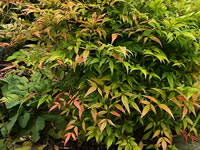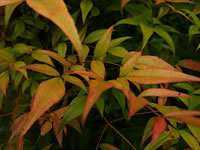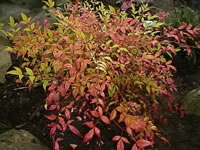How to Grow and Care for Heavenly Bamboo Plants
Nandina domestica
Heavenly Bamboo Plants are completely unrelated to Bamboo.
Their common name comes only from it's resemblance to bamboo due to the fine lacy foliage,
and the cane-like growth pattern of the plant.

|
Growing Heavenly BambooHeavenly Bamboo is classified as an evergreen shrub, but it will lose it's foliage and the canes may die back to the ground at -10°, but they will come back readily the next spring.What makes Heavenly Bamboo special is the color it provides in the garden during all four seasons of the year. In the spring, the new foliage emerges as bright bronzed red, and is soon followed by large, six to twelve inch panicles of creamy white flowers early in the summer. As the seasons change, the foliage changes to a bluish green, then fades to a light green. Clusters of bright green berries replace the flowers and by late summer the berries will ripen to a bright red. In the fall, the foliage color again begins to change to shades of pink and red, ending the year with bright red leaves and berries. The berries will remain until they are discovered and enjoyed by the local birds. Heavenly Bamboo will slowly grow to 8 feet if it is left alone, but it can be kept at a very compact size by pruning, which makes it an excellent choice for entryways, patios or foundation plantings. |
Heavenly Bamboo is also suitable for growing as a container plant in your home.
The flowers of Nandinas attract bees, the berries will attract mockingbirds, cedar waxwings, and robins.
Once established this is one of the toughest plants you'll find, adapting itself to a wide variety of conditions.
Growing Requirements for Heavenly Bamboo
Heavenly Bamboo is hardy in USDA zones 5-10Nandina can be grown in partial shade, but the foliage colors will be much more intense if it is grown in full sun, with a little shade in the hottest part of the day.
Select a location that is protected from harsh winds.
Heavenly Bamboo should be planted in a reasonably rich acidic soil, with a pH Range: 3.7 to 6.4.
|
Preferably the soil should be kept moist at all times, but well established Nandinas will survive periods of drought quite well. Nandina should be planted (or transplanted) during the cooler months of the fall. Pruning and Propagating Heavenly BambooCareful pruning produces much denser growth. Pruning should be done in the spring by removing the oldest branches and any weak growth at ground level.You can safely remove up to 1/3 of the canes. It is possible to grow Heavenly Bamboo from seeds, but germination can take several years. It is better to increase your supply of Nandinas by taking softwood cuttings from new growth during the warm weather. |
|
 |
 |
 |
Search The Garden Helper: